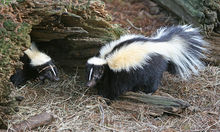Two people in York County, South Carolina were exposed to rabies on January 7, 2016 while caring for a horse. The horse first appeared to be lame but then exhibited aggressive behavior, officials said. The horse was euthanized on Jan. 8 and was confirmed to have rabies this past Monday.

Skunks and other wild life - A source of rabies in horses
A South Carolina horse that first appeared to be lame, but then exhibited aggressive behavior, has been confirmed to have had rabies after being euthanized.
© 2016 by Tomfriedel
These two people are now being treated for rabies in the Rock Hill area after the horse tested positive, according to the Department of Health and Environmental Control.
The law does not require owners of agricultural animals to vaccinate for rabies; however, rabies vaccines for cows, horses and sheep have been approved by the U.S. Department of Agriculture.
The horse from York County is the first animal from that county to test positive for rabies in 2016. There have now been two confirmed cases of rabies statewide in 2016. Nine animals tested positive in York County in 2015 and a total of 130 confirmed cases of animal rabies in South Carolina in 2015.
While rabies is common in some animal species in some regions, itâs a pretty rare disease in horses, so this is a noteworthy event.
What horse owners should know about rabies:
Rabies can be sneaky. Especially in horses, rabies isnât always obvious at the beginning.
Affected animals can have vague signs that point to other types of disease, such as colic. In this case, the horse was reported to be lame the day before the onset of obvious neurological disease.
Rather than real orthopedic pain, that was likely actually the onset of signs of rabies. Thatâs not to say that every horse with a sore leg or belly should be considered a rabies suspect. It means that we have to be aware that rabies doesnât always occur in textbook form.
Rabies in horses is a public health risk. However, in horses, the main risk is probably being injured or killed from a neurologically abnormal horse that might attack or fall on someone. . In this case, two people were exposed and are undergoing post-exposure prophylaxis.
Rabies vaccination is cheap protection. By nature of their lifestyle, horses are at almost constant risk of exposure to wildlife, the main source of rabies in North America.
Reasons for vaccination for all horses
Horses frequently come in contact with skunks, foxes, bats, and other animals that may have rabies and can be infected by a bite from a rabid animal. Often, these bites, which are usually on the muzzle or lower legs, go unnoticed.
The virus which is in the saliva of the rabid animal replicates in the bite wound and travels through the peripheral nerves to the central nervous system. The incubation period can be as short as two weeks or as long as several months. Horses often die within three to five days of the onset of clinical signs.
In most areas of the country, bites from skunks are the primary way horses contract rabies, but in New England and throughout the southeastern states, rabid foxes and bats are also known to infect horses.
Several practical steps can be taken to prevent a horse from contracting rabies. A routine, yearly rabies vaccination program for all horses, dogs, and cats in endemic areas should be followed. Although not 100% effective, the vaccine is usually highly protective.
Any horse bitten by a wild animal should be considered exposed to rabies and should be re-vaccinated immediately. If an unvaccinated horse is bitten, the horse should be quarantined and kept under observation for six months. Rabies is a reportable disease and should be disclosed to the local health authorities.
Treatment for horses with rabies
Once clinical signs appear, it is usually too late for any effective treatment because progression of the disease is very rapid and most horses die within three to five days after exhibiting clinical signs.
Horses that are known to have been exposed to rabies should have all wounds cleaned and lavaged with a disinfectant recommended by a veterinarian. Rabies antiserum should be infiltrated around the bite wound.
Because of the serious public health risk and fatal nature of the disease, a horse showing clinical signs with a diagnosis of rabies should be euthanized immediately.
